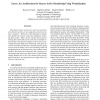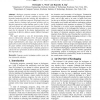57 search results - page 10 / 12 » A semantics-based approach to malware detection |
CCS
2007
ACM
14 years 1 months ago
2007
ACM
Remotely-launched software exploits are a common way for attackers to intrude into vulnerable computer systems. As detection techniques improve, remote exploitation techniques are...
WWW
2010
ACM
14 years 4 months ago
2010
ACM
JavaScript is a browser scripting language that allows developers to create sophisticated client-side interfaces for web applications. However, JavaScript code is also used to car...
SP
2008
IEEE
14 years 4 months ago
2008
IEEE
Host-based security tools such as anti-virus and intrusion detection systems are not adequately protected on today’s computers. Malware is often designed to immediately disable ...
IEEEARES
2010
IEEE
14 years 4 months ago
2010
IEEE
—Program obfuscation is often employed by malware in order to avoid detection by anti-virus software, but it has many other legitimate uses, such as copy protection, software lic...
CSREASAM
2010
13 years 7 months ago
2010
Abstract-- Keylogger programs attempt to retrieve confidential information by covertly capturing user input via keystroke monitoring and then relaying this information to others, o...


